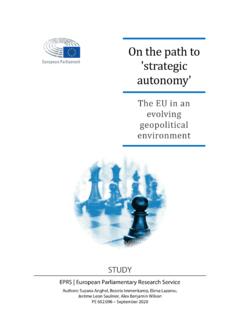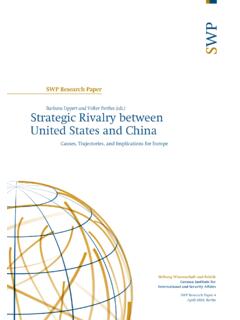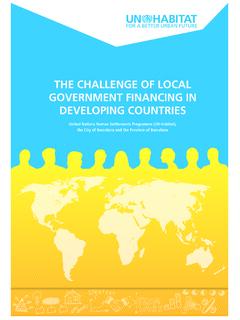Transcription of Strategic Planning in an Educational Development Centre ...
1 207 Strategic Planning in an Educational Development Centre : Motivation, Management, and Messiness Simon P. Albon, Isabeau Iqbal, and Marion L. Pearson University of British Columbia Strategic Planning in universities is frequently positioned as vital for clarifying future directions, providing a coherent basis for decision-making, establishing priorities, and improving organizational performance. Models for successful Strategic Planning abound and often present the process as linear and straightforward. In this essay, we examine our own experiences of Strategic Planning for a new Educational Development Centre situated in a Faculty of a research intensive university. Drawing from the literature, we provide a brief history of Strategic Planning in university contexts and consider criticisms and benefits.
2 We investigate complicated issues related to our own process and, throughout, we argue that in spite of established formulas for creating a Strategic plan, the process is non-linear and messy. We end this paper with recommendations for Educational developer colleagues. Introduction f you don t know where you re going, any road will take you there. - Carroll, 1865 While in theory Strategic Planning is of a Strategic plan is more analogous to conducting an orchestra. - Hinton, 2012 The words Strategic Planning can elicit visceral responses: rolling eyes, sweating palms, and feelings of futility, to name a few. For some individuals working in higher education, Strategic Planning may be considered a distraction from our real work of teaching and research.
3 The literature on Strategic Planning , however, positions this activity as vital for clarifying future directions, important for developing a coherent basis for decision-making, necessary for establishing priorities, and helpful at improving organizational performance (Shah, 2013). The literature also abounds with models for successful Strategic Planning that elaborate on the steps to follow. Often, these steps are presented as linear and relatively straightforward. Our own view is that Strategic Planning is complex, chaotic, and frequently detached from daily activities and decision-making (Mintzberg, 1994; Sevier, 2003). This article is based on our experiences of developing a Strategic plan for the teaching and learning Centre in our Faculty.
4 Having been involved in Strategic Planning previously but never leading the process, we presented some of these experiences at the round table sessions at the 2015 Society of Teaching and Learning in Higher Education Conference. The intent was to share with and learn from like-minded colleagues and more experienced Strategic planners from other post-secondary institutions to build our understanding of Strategic Planning generally and our own processes specifically. In the current work, we I 2016 CELT Vol IX Collected Essays on Learning and Teaching, Vol. IX 208 argue that in spite of established formulas for creating a Strategic plan, the process is non-linear and messy. We begin with a literature review highlighting those areas that have been particularly helpful for building our current understanding of Strategic Planning and for framing our Planning efforts.
5 Included is a brief history of Strategic Planning in universities and important criticisms and benefits of Strategic Planning . We then outline the stages of our own Planning process and draw attention to elements of our academic background and culture that hindered or supported us. We emphasize the complexities of Strategic Planning and end by offering lessons learned and recommendations based on our understandings of what worked and what did not. History of Strategic Planning in Universities While Strategic Planning has its roots in the military, modern conceptions originated in the business practices of the early twentieth century (Sheridan, 1998; Taylor, 1911).
6 Increasingly valued as a standard business management tool in the post-World-War-II decades, Strategic Planning remained mostly a private sector undertaking until the late 1970s (Candy & Gordon, 2011). The growing difficulties experienced in the university sector at that time helped shift the uneasy alliance between business and higher education. Initially, universities were reluctant to adopt business mindsets to address their challenges, and were resistant to calls of efficiency-minded reformers to run public institutions more like businesses (Hinton, 2012). Notions of product Development , industry growth, market share, and risk management were foreign to university culture, and universities did not view themselves as serving customers.
7 Complicating Planning processes were issues related to university structure such as decentralized power, professional autonomy and tenure, loose coupling of multiple academic units, complex committee structures, and government intervention (Hardy, 1991). However, perspectives changed by the late 1980s. By then, Strategic Planning had emerged in universities as a potential solution for developing a proactive stance in environments of increasing competitiveness and fluctuating enrollments, changing student demographics, inconsistent funding and spiraling costs, and calls for greater accountability, including the rise of accreditation standards (Aleong, 2007).
8 While Planning was not new to universities (Kotler & Murphy, 1981; Sheridan, 1998), Strategic Planning was. Initial university Strategic plans often focused on internal organizational issues, staffing, and resourcing, and produced documents that described the institution and its vision, mission, and value to society but contained limited or unrealistic goals for change (Cowburn, 2005). Created primarily by senior leadership within the institution interested in orderly, systematic management (Dooris, 2002, p. 27), these top-down plans often sat on the shelf and, in some cases, were done merely to appease external stakeholders, such as government funders, alumni, parents, and the general public (Carron, 2010; Chance, 2010).
9 Often, Strategic Planning was a symbolic activity designed as a promotional tool for the university, but with limited acknowledgement of external pressures or plans for adapting to future challenges (Hinton, 2012). As de Haan (2014) states, their use, in short, [was] more a rhetorical device than a practical template for action (p. 137). Throughout the 1990s, perspectives on Strategic Planning changed dramatically in academia as university leaders realized that in a rapidly globalizing and increasingly competitive world there was no longer a status quo for a campus (Wilkinson, Taylor, Peterson, & de Lourdes Machado-Taylor, 2007, p. 12). Instead, laying claim to institutional distinctiveness, finding a unique niche in the higher education marketplace, and being able to attract and keep the best students, faculty, and staff became critical for long-term viability (Aleong, 2007; Keller, 1999).
10 However, despite great effort and improved efficiencies through technology, Strategic Planning left many universities fragmented, unable to cope effectively with societal change, responding reactively rather than proactively to challenges, and incapable of transforming how they functioned as Educational institutions (Baer, Duin, & Ramaley, 2008). Frequently, the gap between Planning and Marketing of Canadian University Rankings 209 implementation impeded meaningful change as the goal of Strategic Planning was about creating the plan rather than using it (Cowburn, 2005; de Haan, 2014; Sevier, 2003). Performance indicators focused on easily quantifiable factors, such as numbers of people ( , students and faculty) and budgets, rather than the quality of education provided or the student experience (Soutar & McNeil, 1996).


















